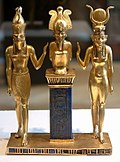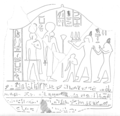This article needs additional citations for verification .(February 2023) |
Twenty-second Dynasty of Egypt | |||||||||||||
|---|---|---|---|---|---|---|---|---|---|---|---|---|---|
| 943 BC–716 BC | |||||||||||||
 Pendant bearing the cartouche of Osorkon II seated Osiris flanked by Horus and Isis | |||||||||||||
| Capital | Bubastis, Tanis | ||||||||||||
| Common languages | Egyptian language | ||||||||||||
| Religion | Ancient Egyptian Religion | ||||||||||||
| Government | Absolute monarchy | ||||||||||||
| Historical era | Third Intermediate Period of Egypt | ||||||||||||
• Established | 943 BC | ||||||||||||
• Disestablished | 716 BC | ||||||||||||
| |||||||||||||
| Periods and dynasties of ancient Egypt |
|---|
All years are BC |
The Twenty-second Dynasty was an Ancient Egyptian dynasty of ancient Libyan origin founded by Shoshenq I. [1] It is also known as the Bubastite Dynasty, since the pharaohs originally ruled from the city of Bubastis. [2]
Contents
The Twenty-first, Twenty-second, Twenty-third, Twenty-fourth, and Twenty-fifth dynasties of ancient Egypt are often combined under the group designation of the Third Intermediate Period.











